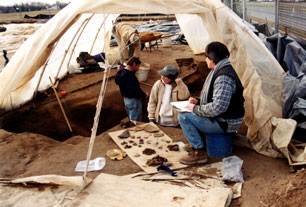Thomas Dawson
Overview of the Dawson Site
The Dawson Site was a small farm, built by Thomas and Mary Dawson some time before 1740 along a road just south of Dover. Thomas Dawson, his wife Mary, their son Richard, and Jenny, an African-American slave, occupied the property until Thomas' death. After Thomas' death in 1756, the property was occupied by tenants until around 1780. Although much of site had been destroyed after the site's abandonment, part of the main house survived.

Excavating the Cellar at the Dawson Site
A series of archaeological investigations were carried out at the site, culminating in data recovery excavations in the winter of 1997-1998. During these excavations, a cellar hole measuring 11.6 by 13.8 feet was exposed and excavated. Well-preserved archaeological deposits were recovered from the cellar hole. Although no other building remains were found, several other pits containing eighteenth-century artifacts were excavated.

Proposed Reconstruction of the
Dawson House Foundations
Archival research and artifact distribution patterns suggested that the farm consisted of the a one-story frame house, a log barn, a shed, and a malt house. The house showed an unusual construction, most notably in the use of wooden ground sills laid on the cellar floor.

Artist's Reconstruction of the Dawson Site
The site yielded an assemblage of 20,000 artifacts and faunal remains, which provided much useful information on the lives of ordinary Delaware farmers like the Dawsons. Analysis and interpretation focused on 18th-century housing, rural industry and crafts, consumer behavior, and the development of a regional culture in the lower Delaware River Valley.








